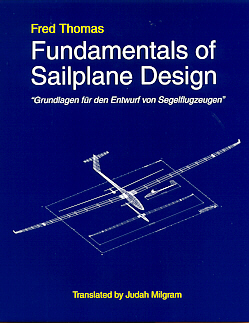 |
While
I was a little hesitant to add a book of this price
range, my mind was quickly changed after just a
few minutes of review. It is very well done and
up to date. It is also one of the very few aircraft
design books I have found which is at the same time
necessarily technically oriented, but also not beyond
the understanding of those without an advanced mastery
of mathematics. Besides just theory, Fundamentals
of Sailplane Design also covers many of the practical
matters for both the aspiring designer and the sailplane
pilot who wants to obtain a mastery of how and why
his/her craft performs as it does.
|
From
the preface: Accomplished soaring
pilots appreciate the need for a sound understanding
of the technical aspects of their sport.
This book, the definitive text on sailplane
design will provide the interested pilot
with a better understanding of his or her
aircraft. To make the material accessible
to those without an engineering background,
an emphasis is placed on physical understanding
and visualization. Mathematics is held to
a minimum.
The book will be of even more interest to
those interested in designing sailplanes.
Because it draws on decades of experience
developed at the German Akafliegs, the material
will help the experienced engineer to quickly
develop a practical understanding of the
considerations that go into the design of
a high performance sailplane.
This third edition reflects the technical
developments since the last German language
edition of 1984. the design data tables
and 3 view drawings now contain entries
for over 150 aircraft. By presenting this
edition in English, it is hoped that this
unique collection of sailplane design information
will become accessible to a wider audience
worldwide. |
|
TABLE
OF CONTENTS
Basics
of Aerodynamics and Flight Mechanics
Fluid Dynamics of the Sailplane 1
inviscid incompressible flow
lift and potential flow
induced drag
viscous effects and boundary layers
concluding remarks
Airfoil and Wing Theory
24
airfoil geometry and coefficients
aerodynamic characteristics
wing planform and lift distribution
Performance and Flying Qualities
43
performance
dynamic
stability
static
stability
Aeroelasticity 57
static
aeroelasticity
dynamic
aeroelasticity problems
Design
Requirements
Certification Requirements 61
Cross-Country Theory 62
modeling cross country flight
climb performance in thermals
interthermal glide
Sailplane
Design Optimization
Basic Considerations
73
Wing Design
73
setting the
aspect ratio
wing loading
airfoil selection
wing planform
and twist
winglets and
unconventional planforms
variable geometry
Flying Wings
114
the SB-13
Genesis
The World Class
116
The "eta" 118
Fuselage and Wing/Fuselage Junction 120
cockpit and
tailboom
wing/fuselage
interface
Empennage and Controls
126
control system
elements on the wing
horizontal
stabilizer and elevators
stabilizer
volume
stabilizer
planform and empennage
stick force
gradient with flying tails
Evaluation
of Performance and Flying Qualities
Theoretical Methods 155
drag polars
typical drag polars
Experimental Methods 157
wind tunnel testing
flight test
Trends
in Sailplane Development
Class Definitions
173
Evolution of the Sailplane
174
wooden sailplanes
metal sailplanes
fiberglass
sailplanes
Outlook
185
Appendix
Sailplane design Data and Drawings
195
Flight Test Protocol 245
Nomenclature
261
Aircraft Index
273
|

